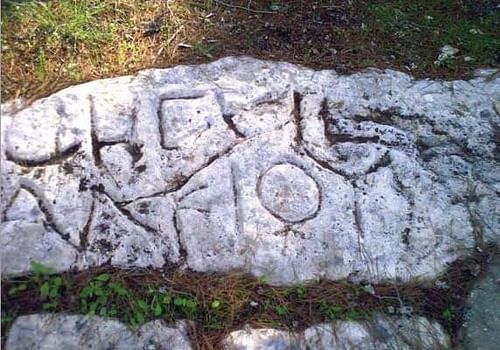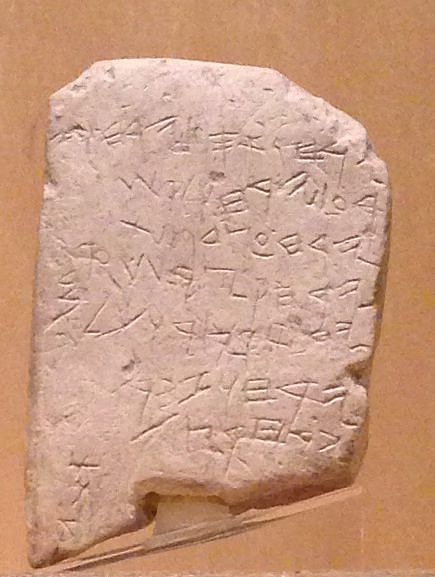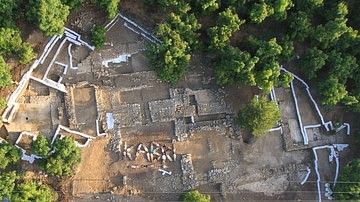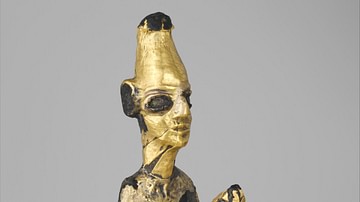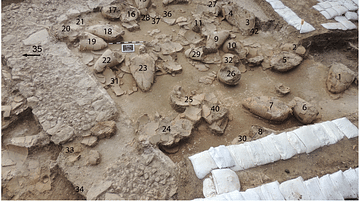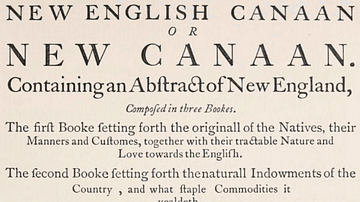The archaeological site of Tel Gezer is located in central Israel at the edge of the western mountains near the Shephelah, about 9 or 10 km southwest of the city of Ramleh. Gezer was one of the famed "Solomonic" cities of the Hebrew Bible, said to have been fortified by Solomon (1 Kings 9:15–17), and the city appears in a number of Biblical accounts.
Like many archaeological sites in the Levant, Tel Gezer is centered on a man–made mound called a tell. A tell consists of several layers or 'strata', each of which contains the material remains of a period of human habitation and now rests on the layer representing the previous period of habitation and beneath the remains of the period that followed. The mound of Tel Gezer is about three times as long as it is wide - about 650 m long running east to west, by 200–250 m wide, and is, with a hill on the east and west ends, connected by a low point called the "saddle".
Occupation of the Site
Tel Gezer was occupied over a period of more than 3,000 years, from the latter half of the 4th millennium BCE through the 1st century CE. It was not fortified until the Middle Bronze Age (MB, c. 2000–1500 BCE), when fortifications were first built, including stone walls and towers, a glacis and a gate on the western hill. Later on, additional fortifications and monumental structures were built, especially in the Iron Age sometime during the period from the 10th through the 8th century BCE. The site continued to be inhabited, except for brief periods, until sometime in the 1st century CE.

Summary of Excavations
Since the site was discovered in 1870, it has been excavated several times. The first excavation was conducted by the Irish archaeologist R.A.S. Macalister for the Palestine Exploration Fund (PEF) in the early 20th century. The site was then excavated by a joint expedition of the Hebrew Union College Biblical and Archaeological School in Jerusalem (HUC) and the Harvard Semitic Museum, from 1964–1976 and then by teams from the University of Arizona in 1984 and 1990. Excavations are currently being conducted by two groups. One is from the Tandy Institute for Archaeology at the Southwestern Baptist Theological Seminary (SBTS) and began work in 2006. The other, from the Moskau Institute for Archaeology at the New Orleans Baptist Theological Seminary (NOBTS), began its excavations in 2010 and is focusing on the Gezer water system (See Tel Gezer Water System Project advertisement).

Perhaps the most notable archaeological development at the site in recent years was the discovery of evidence in the summer of 2015 that the Gezer water system was constructed in the MB, perhaps as early as 2000 BCE, unlike the water systems at Megiddo and Hazor which date to the Iron Age. In addition, as in the case of Megiddo and Hazor, the dating of the "Solomonic" Iron Age structures at Tel Gezer is being re-examined by scholars of the Ancient Near East.
Discovery & Identification of the Site
Tel Gezer was discovered and identified by the famous 19th century CE French adventurer and scholar of the Holy Land, Charles Clermont-Ganneau. In 1870, Clermont-Ganneau read about a site called Tel ej-Jazar, and this Arabic name reminded him of the name of Biblical Gezer. He visited the site and in 1874, found two inscriptions in stone which he believed marked the boundaries of ancient Gezer. A total of nine inscriptions indicating the boundaries of Gezer have been found in total - all dating from the Roman period.
The Macalister Excavation – 1902-1905 and 1907-1909
The first excavation of Tel Gezer was conducted by R.A.S. Macalister for the PEF 1902-1905 and 1907-1909. In his excavation, Macalister discovered four sets of walls spanning more than two-thirds of the period of occupation of the site:
-
From MB IIC, the Inner Wall with a triple gateway,
-
From the Late Bronze Age (LB), the Outer Wall, and
-
From the Solomonic period of the Iron Age (10th century BCE), the casemate wall, consisting of two parallel walls separated into compartments by stone crosspieces.
Macalister made a number of remarkable archaeological discoveries. He excavated the High Place and found the Gezer Calendar which describes the annual cycle of agricultural activities and dates to the 10th century BCE, making it the oldest Hebrew inscription ever found. He also found several archaeological treasures, including Egyptian imports, Philistine pottery, and Persian silver pieces.
However, the objects were of limited archaeological value because the findspots of the objects and their context were not properly recorded. Most importantly, Macalister did not perform a recognizable stratigraphic investigation and analysis and did not record the elevations at which the various objects were found. Instead of identifying the strata of findspots, he classified the pottery and other materials he found according to periods, identifying eight periods as follows: the Pre-Semitic period, the First through Fourth Semitic periods, and the Persian, Hellenistic, and Roman periods. Macalister also made a serious error in dating the Iron Age gate, which he dated to the Maccabean period, centuries later than its actual date.
The work was not done systematically, probably because Macalister was the only archaeologist on a project working with large numbers of laborers, and because stratigraphic techniques had been developed only a few years earlier.
Weill & Rowe Excavations – 1914, 1924, and 1934
In 1914 and 1924, areas around Tel Gezer owned by Baron Rothschild were excavated by Raymond-Charles Weill, working for Rothschild. Reports of the excavations were not published until 2004, 80 years after the later of the two excavations. In 1934, a new expedition to Gezer was initiated by the PEF under the direction of British archaeologist Alan Rowe. This was to be a full-scale excavation, but the areas identified for excavation turned out not to be workable, and so the project was abandoned after about six weeks.
The HUC & Harvard Project – 1964-1974
In 1964, the first major excavation of Tel Gezer since Macalister's expedition more than 50 years earlier was launched. The new excavation was sponsored jointly by the Hebrew Union College Biblical and Archaeological School in Jerusalem (HUC) and the Harvard Semitic Museum.
The HUC-Harvard Expedition adopted an innovative approach to the staffing and administration of the dig, that was soon to be followed by most excavations led by American universities. For the first time, the expedition used student volunteers instead of paid laborers. It also offered the first field school for students on a dig. Following the New Archaeology that had emerged shortly before, It used specialists to explore specific issues involving the natural and social sciences and the arts, such as zoology, botany and geology.
The director of the project in the first season was G. Ernest Wright of Harvard, a legendary archaeologist long associated with the American Schools of Oriental Research (ASOR). William G. Dever then served as director for seven seasons, 1965-1971, followed by Joe D. Seeger 1972-1974. Excavations continued in 1984 and 1990, under the direction of Dever but sponsored by the University of Arizona.
The HUC-Harvard Expedition re-excavated areas dug by Macalister, and also opened up new areas. It found more than 20 strata dating from about 3000 BCE to 100 CE.
The Middle Bronze AGE & Late Bronze Age
Some of the most notable discoveries of the Expedition dated to the MB and the LB. The excavators found the Inner Wall and a 25-foot (c. 7.5 m) high glacis, both dated to the MB IIC. They also re-examined the High Place found by Macalister. This was a series of ten standing stones which may have served some ritual purpose but may also have commemorated an agreement or treaty among different tribes. The HUC-Harvard excavators dated them to MB IIC. Discoveries dated to the LB included the Outer Wall and a great palace with Egyptian treasures dated to the Amarna period (14th century BCE) which was apparently destroyed by Merneptah at the end of the 13th century BCE.
The Iron Age
In their excavation of the Iron Age strata, the HUC-Harvard excavators discovered the towers of the Outer Wall and a casemate wall - two parallel walls connected by perpendicular cross pieces which create a series of chambers.
In the Iron Age, a six-chambered gate was built on the saddle. While the HUC-Harvard excavation was going on, or shortly before, the great Israeli archaeologist Yigael Yadin re-examined Macalister's dating of the gate at Gezer (erroneously dated by Macalister to the Maccabean period) and attributed the Gezer gate, as well as the gates at Megiddo and Hazor, to Solomon in the 10th t century BCE. However, other archaeologists have since adopted a "low chronology" and have re-dated the gates and certain other massive structures to later dates - in the 9th and the 8th centuries BCE.

The excavators also found that the apparent gap in the occupation of the site from the 10th to the 6th century BCE was probably due to the fact that Macalister had not published reports related to this period. There was evidence of the Neo-Babylonian destruction in the late 7th or early 6th century BCE.
The Current Expedition – 2006 to Present
The archaeological expedition currently responsible for the overall excavation of the site is called the Tel Gezer Excavation and Publication Project and is sponsored by the Tandy Institute for Archaeology at the Southwestern Baptist Theological Seminary (See Tel Gezer Excavation and Publication Project advertisement).
The expedition began work in 2006 and has been concentrating on the Iron Age strata of the mound. The team has excavated the Iron Age layers on the south central side of the mound, seeking to connect the Iron Age structures uncovered by the HUC-Harvard project with those found by the current expedition. They are also examining urbanization during the Iron Age in an area to the west of the six-chambered gate, as well as in other areas where Iron Age public buildings and domestic structures are located. Most of the material found by the current excavators dates to the 10th, 9th and 8th centuries BCE, as well as the Hellenistic period, although only a limited amount of material from the Solomonic period has been found. The current directors of the project are also re-examining the dating of the six-chambered gate, but for the moment, they continue to maintain that the gate dates to Solomon and the 10th century BCE, as Yadin said.

